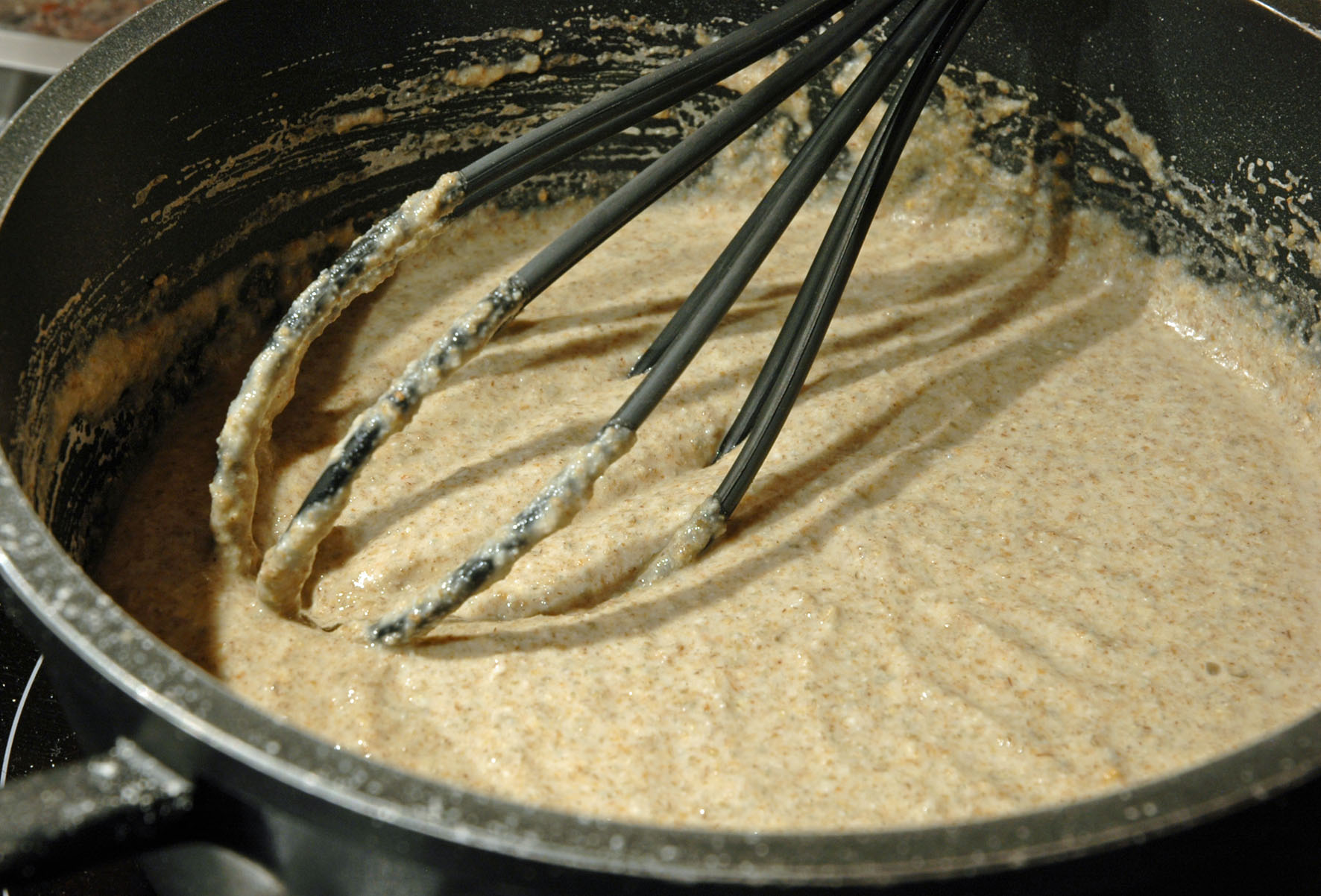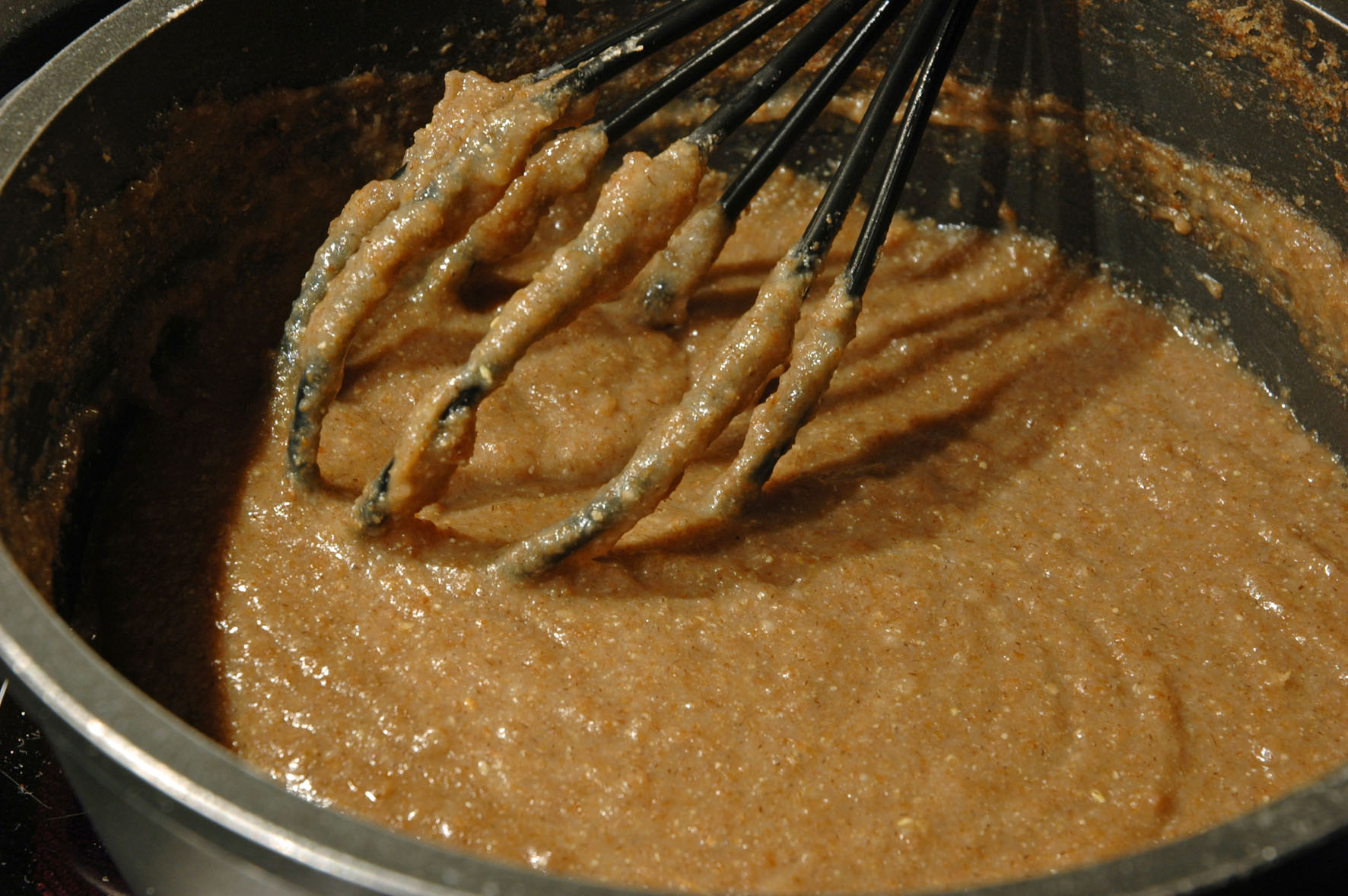Bäckermeister Wolfgang Süpke aus Thüringen gab vor etwas mehr als einem Jahr eines seiner Rezepte preis – die „Meister Süpke Kruste“. Vor einer Woche haben wir im Brotbackforum gemeinsam dieses Brot gebacken und ich war sehr angetan vom Geschmack und von der Frischhaltung des Brotes.
Ein Teil des tollen Aromas dieses Brotes kam aus einer Zutat, die ich bislang noch nicht kannte: das „Aroma-Stück“. Hierbei wird unter Verwendung von enzymaktivem Backmalz ein Teil der Gesamtmehlmenge eines Brotes mit Wasser verquollen. Dies geschieht langsam bei einer Temperatur von 60-65°C in einem Topf. Hierbei spalten die im aktiven Backmalz vorhandenen Amylase-Enzyme die Stärke des Mehls in Maltose (Malz-Zucker), gleichzeitig bräunt die Masse und dickt etwas ein. Heraus kommt ein hocharomatisches süß-malziges Mehl-Kochstück, das man als Zutat an fast alle Brotteige geben kann, um sie noch aromatischer zu machen.
Bäcker Süpke empfiehlt feines Roggen-Schrot zur Herstellung, aber man kann sicher auch alle anderen Mehlsorten verwenden. Ich habe Roggenvollkornmehl genommen. Der Phantasie sind beim Aroma Stück keine Grenzen gesetzt. Es ist auch möglich, Saaten zuzugeben. Damit hat man diese gleich auch vorgequollen und braucht sie nicht getrennt vorbereiten. Man kann das Aroma-Stück in größeren Mengen vorbereiten und einfrieren. Wenn es gebraucht wird, taut man es einfach auf.
Ich würde empfehlen, maximal 15 % der Gesamtmehlmenge als Aroma-Stück zu verwenden. In den nächsten Wochen werden ein paar neue Rezepte mit Aroma-Stück hier im Blog erscheinen, den Anfang macht nächsten Donnerstag eine Neuauflage meines „Kommissbrotes“.
So wird das Aroma-Stück hergestellt:
300 g Roggenvollkornmehl
600 g Wasser (doppelte Menge)
11 g enzymaktives Malz
Die Zutaten in einem Topf gut verrühren.

So sieht das Aroma-Stück vor dem Erhitzen aus.
Langsam auf 60-65°C erhitzen. Man kann das in einem Wasserbad machen oder bei sehr niedriger Hitze auch auf der Kochplatte, hierbei die Temperatur kontrollieren. Wenn es am Anfang zu heiß wird, zerstört das die Enzymtätigkeit und das Aroma-Stück wird nicht süß. Dann läßt man es bei möglichst konstanter Temperatur mindestens 2 Stunden simmern. Den Topf abdecken. Zwischendurch immer wieder durchrühren. Wenn es fertig ist, die Masse einmal kurz aufkochen, damit die Enzymaktivität beendet wird, sonst kann das im Hauptteig vor allem bei kalten Teigführungen oder bei roggenlastigen Teigen Probleme machen.

Nach dem Kochen – das Aroma-Stück hat eine braune Farbe angenommen und schmeckt malzig-süß.
The aroma-stueck
One year ago german master-baker Wolfgang Süpke from Thuringia revealed one of his prized recipes for a down-home typical german rye-bread, the „Meister Süpke Kruste“. One of the ingredients of his dough is a so called „aroma-stueck“. I cannot fathom a fitting translation in english, so I left the name as it is. I have experimented with aroma-stueck in various doughs and came to the conclusion, that aroma-stueck may be one of the „secrets“, that make our traditional breads so tangy aromatic and savoury.
Basically it is a „water-roux“ of fine ground rye meal and water, which is mixed with diastatic malt and being macerated in a pot or a Thermo-Mix at 60-65°C for a minimum of 2 hours.
The amylase-enzymes of the malt convert the starch into maltose, thus giving the mixture a brownish colour and a quite sweet malty taste. The rest of the starch soaks up the water and improves juicyness of the crumb and the freshkeeping qualities of the bread.
One can be very creative with the ingredients: all kinds of flours and even seeds can be added. Adding seeds will create even more aroma and the seeds will have time to get soaked, too. One can prepare a big ammount of aroma-stueck in advance, freeze it in small portions and just thaw it when needed. It can be added to almost every dough, when a malty crumb-aroma is feasible. Up to 15 % of the flour in a dough can be substituted with aroma-stueck.
How to prepare an aroma-stueck:
600 g water
300 g fine-ground rye or whole-rye-meal
11 g diastatic malt
Mix the ingredients in a pot and heat up carefully to 60-65°C, taking care not to heat it up hotter than that. The enzymes will be denaturated and cease working at higher temperatures. Let the mass simmer in a covered Pot or a Thermo-Mix for a minimum of 2 hours. Stir every 20 minutes. The mass will eventually turn brown and get a sweet malty taste. After two hours the mass should then be heated up to 80-90°C, to cease enzyme-activity. Otherwise it could create problems in long-fermented doughs or rye-doughs, which do not develop well with diastatic malts. Let the mass cool down to room temperature and use it in the dough, or freeze it for later use.
